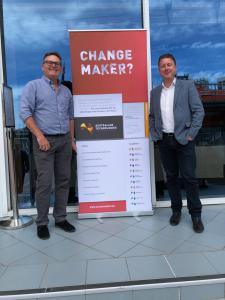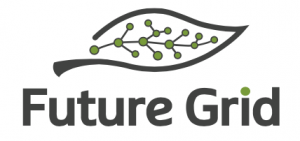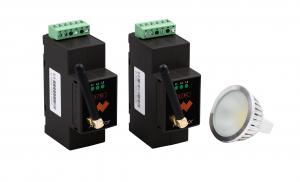
Energy tech winners co-creating data hub for billions of electricity measurements a day
Analysing vast amounts of data to manage and control electrical circuits over the internet in real time is a threshold challenge for achieving the 'Smart Grid'.
Energy technology companies Wattwatchers and Future Grid are both presenting at the finale of the 2017 ATC in Sydney today (November 16th), and are respectively the 2016 and 2017 winners of the top national award for innovation in the ‘New Energy’ space.
The ‘energy data hub’ project - being jointly developed to address a critical infrastructure barrier for the long-talked-about, yet still-to-be-realised ‘Smart Grid’ - has three core pillars:
1. Real-time data at circuit level to show what’s happening ‘right now’ in highly-granular detail.
2. Historical data and analytics that put ‘right now’ in context and allow more accurate predictions.
3. Control based on the value-added data to switch any number of circuits and steer energy flows.
The Wattwatchers-Future Grid energy data hub will enable the real-time management over the internet of fleets of intelligent devices that monitor and control electrical circuits covering everything from rooftop solar generation, to energy storage systems, to electric vehicle chargers and everyday major loads in the the household including hot water, air-conditioning units, pool pumps and more.
With growing national and international attention on the intersection of data technologies with clean and distributed energy technologies, one of biggest challenges is how to scale up when per-meter energy measurements move from dozens or hundreds a day for traditional utility smart meter rollouts, to 100,000 or more a day for future-ready devices like Wattwatchers.
The Wattwatchers-Future Grid initiative coincides with national attention on getting more data accessibility for consumers and third party service providers out of utility-style smart meters used in the regulated energy market, including:
-The COAG energy ministerial council’s consumer data initiative, which will be reporting in the middle of 2018
-The Victorian Government’s Energy Data Hub plan based on data from the nation’s largest fleet of utility smart meters installed at 3 million sites across the state, with a ‘proof of concept’ project scheduled for next year
-The Productivity Commission push to open up consumer access to data held by industries and governments, including energy data
-The Finkel Report recommendation to ‘facilitate measures to remove complexities and improve consumer access to, and rights to share, their energy data’
-Energy Consumers Australia activity to transform how consumers and service providers can get online access to more data
-Australian Competition and Consumer Commission investigations into the energy sector
Wattwatchers CEO Gavin Dietz, who worked in the mainstream global smart meter manufacturing industry for nearly a decade, said that moving the energy sector into the consumer tech area was crucial to transforming to a cleaner, more secure and cost-effective future.
‘The energy data hub model that Wattwatchers and Future Grid are creating together is based on completely different, far more contemporary technologies than the utility-style advanced metering infrastructure (AMI) that is used mainly for billing consumers and reconciling with energy markets.’ said Dietz.
‘Our model is a powerful data platform that sits outside of the regulated market - with a suite of independent hardware, firmware and software - providing the underlying infrastructure for an intelligent ecosystem of services and applications that will be useful for everyone from householders to grid managers and market operators, allowing multiple use cases simultaneously.
‘Many people are starting to outline a super-intelligent future electricity system, but they aren’t always understanding the full challenge posed by the enormous amounts of data that will need to be analysed and acted upon in real time - simultaneously covering millions of generation, storage and consumption points for millions of homes and businesses.’
Future Grid Co-Founder and Managing Director Chris Law said that the overarching objective of the platform was to empower consumers with smarter applications and services, whether householders use the data themselves or approve its use by third parties who help them with energy solutions.
‘This kind of massively scalable, ultra-smart infrastructure doesn’t just happen of its own accord,’ said Law. ‘Someone has to conceive it and make it happen, and that’s what Future Grid and Wattwatchers are doing.
‘It’s vital to understand the orders of magnitude for the data that’s becoming available. A single Wattwatchers device can generate over 100,000 energy data measurements a day, and Wattwatchers is aiming to have hundreds of thousands of its devices in the field.
‘That will be tens of billions of data points a day, and the data itself is really only the tip of the iceberg. It’s when you actually want to do something with data to add value that seven-eighths of the heavy lifting comes in, and that’s what drives the real demand for the kind of processing power that Future Grid brings to the equation.
‘The energy data hub is not the end product, it’s the platform for a marketplace of solutions. It provides the operational and support layer that enables other services and apps that will interface with householders and business people, and when it’s doing its job most consumers won’t even know it’s there.
‘What they’ll be seeing is a user-friendly, software-as-a-service solution that helps them to do valuable things like saving energy, reducing bills, optimising rooftop solar, and participating in energy rewards programs in their local area.’
The first iteration of the Wattwatchers-Future Grid energy data hub will be operational early in 2018, with regular updates to follow.
Murray Hogarth
Wattwatchers
+61 417 267235
email us here
EIN Presswire does not exercise editorial control over third-party content provided, uploaded, published, or distributed by users of EIN Presswire. We are a distributor, not a publisher, of 3rd party content. Such content may contain the views, opinions, statements, offers, and other material of the respective users, suppliers, participants, or authors.




